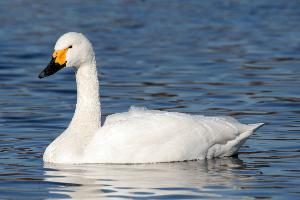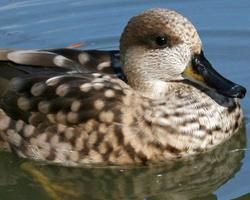
Poids et mesures
| Longueur | de 40 à 47 cm |
|---|---|
| Poids | de 500 à 1400 g |
| Envergure des ailes | 72 cm |
Statut de conservation
| Intrépide |
Description de l'animal
The Tufted Duck (Aythya fuligula) is a medium-sized diving duck that is easily recognizable by its distinctive physical features and behaviors. This species is a member of the Anatidae family, which includes ducks, geese, and swans. The Tufted Duck is a widespread and common species across much of its range, which spans across Eurasia and parts of North Africa. It is also a frequent visitor or winter resident in parts of the Indian subcontinent and Southeast Asia.Adult Tufted Ducks typically measure between 40 to 47 centimeters in length, with a wingspan ranging from 67 to 73 centimeters. They exhibit sexual dimorphism, meaning males and females have noticeably different appearances. Males are characterized by their striking black and white plumage. During the breeding season, they display a glossy black head, neck, breast, and back, contrasting sharply with their white flanks. One of the most distinctive features of the male is the long, tufted crest on the back of its head, which gives the species its common name. The eyes are bright yellow, adding a splash of color to their otherwise monochrome appearance. Females and juveniles, on the other hand, are more subdued in color, with brownish bodies and paler flanks. Their heads are brown with a slight tuft, and their eyes are a darker yellow compared to the males.
Tufted Ducks are highly adaptable and can be found in a variety of aquatic habitats, including lakes, rivers, and ponds with plenty of vegetation, which provides them with ample food and cover. They are particularly fond of deep, clear waters. As diving ducks, they are adept swimmers, using their strong legs and webbed feet to propel themselves underwater in search of food. Their diet is varied and includes aquatic plants, seeds, and small invertebrates such as insects, mollusks, and crustaceans.
During the breeding season, which typically begins in late spring and extends through the summer, Tufted Ducks become more territorial. They nest near the water's edge, with the female constructing a well-hidden nest among vegetation. The nest is a simple structure lined with down, where the female lays between 8 to 11 eggs. She incubates the eggs alone for about 25 to 29 days, during which the male may remain nearby or join flocks of other males. Once hatched, the ducklings are precocial, meaning they are relatively mature and mobile from the moment of birth. They are able to feed themselves but remain under the watchful eye of the female until they are ready to fledge.
In the winter months, Tufted Ducks often migrate to warmer climates, although populations in milder regions may remain year-round. During this time, they can be found in larger flocks, sometimes mixing with other species of ducks.
The Tufted Duck is currently listed as Least Concern by the International Union for Conservation of Nature (IUCN), indicating that it is not at immediate risk of widespread decline. However, like many waterfowl species, it faces threats from habitat loss, pollution, and climate change. Conservation efforts aimed at preserving wetland habitats are crucial for ensuring the continued survival of this and other water-dependent species.
In summary, the Tufted Duck is a fascinating and adaptable waterfowl species with distinctive plumage and behaviors. Its ability to thrive in a variety of aquatic environments has allowed it to maintain stable populations across a wide range. Nonetheless, ongoing conservation efforts are essential to mitigate the threats it faces and ensure its future in the wild.
Animaux similaires
Nouvelles photos d'animaux
Top 10 des animaux
- Dolphin gull (Leucophaeus scoresbii)
- Diana monkey (Cercopithecus diana)
- Moustached guenon (Cercopithecus cephus)
- Galápagos tortoise (Geochelone nigra complex)
- Japanese macaque (Macaca fuscata)
- Russian tortoise (Testudo horsfieldii)
- Stone loach (Barbatula barbatula)
- Greek tortoise (Testudo graeca)
- Common flying dragon (Draco volans)
- Vendace (Coregonus albula)


